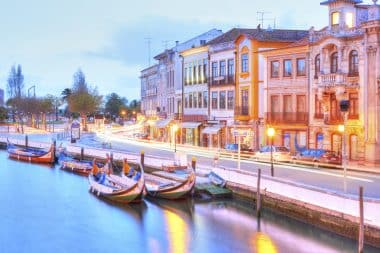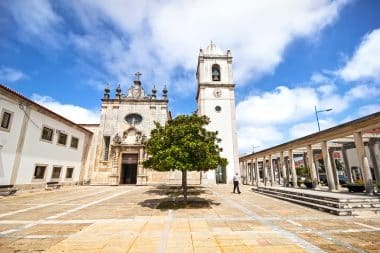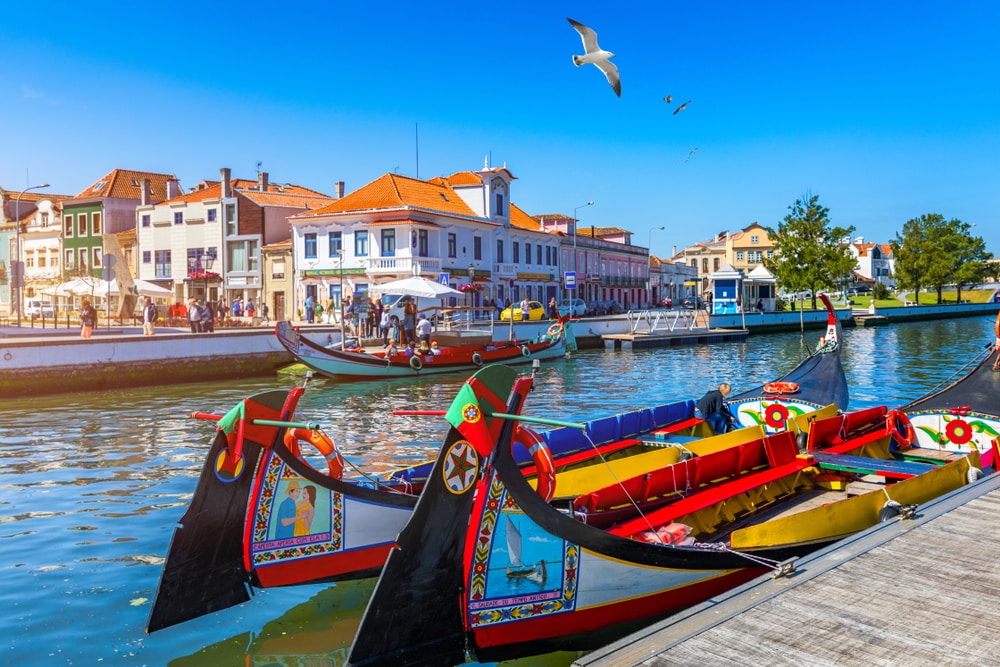The Portuguese city of Aveiro has a romantic feel and is somewhat reminiscent of Venice. This is no wonder, because Aveiro is full of canals over which brightly painted wooden boats, the moliceiros, sail. Aveiro is located directly on the Ria de Aveiro lagoon. Salt is still mined here today. Salt mining is not only characteristic of Aveiro, it also established the former wealth of the city. In addition, Aveiro captivates with magnificent Art Nouveau buildings, sublime churches and an enchanted-looking fishermen’s quarter that is bursting with originality. In addition, Aveiro is a young city. Founded in 1973, the University of Aveiro has an excellent reputation and attracts many young people to the city. In addition, Aveiro is only a few kilometers from the Atlantic Ocean. After extensive sightseeing, a visit to the city can be easily combined with a beach holiday.
Experience Aveiro’s canal landscapes from a traditional moliceiro

If you visit the city of Aveiro, which has a population of around 80,000, you should definitely take a canal tour. This is done in the classic way on one of the traditional fishing boats. This means that it goes over three canals that flow through the entire old town. From the boat you have a wonderful view of the finely decorated and mostly pastel-colored Art Nouveau houses that are lined up along the canals. In addition, the original fishing boats, i.e. the moliceiros, are a sight in themselves. They are all richly decorated and colorfully painted with numerous motifs. So it’s worth taking a look at the other moliceiros passing by during the ride, because each of them is uniquely painted and designed.
A walk through the picturesque old town of Aveiro
But Aveiro can be explored not only by boat, but also on foot. The old town is characterized by an exciting mixture of urban liveliness, fishing tradition with colorful market hustle and bustle and wonderful architecture. In the middle of the city is the Mercado do Peixe fish market, which has been in operation for more than 100 years. It is housed in a permanent building and is not only used for the trade in fish and other marine animals. On the upper floor of the Mercado do Peixe, freshly prepared fish dishes can be enjoyed.
Continue to Praça de Rossio, where Aveiro’s most interesting Art Nouveau buildings are lined up. Worth seeing are, for example, the Coreto do Parque Municipal Infante Dom Pedro and the Edíficio da Casa dos Ovos Moles. By the way, Ovos Moles are a culinary specialty that can only be found in Aveiro and that you should definitely try once in your life. This is not, as the direct translation into German might promise, soft eggs, but a candy. It is mixed with egg yolks and a lot of sugar. The confectioners fill the resulting mass into a kind of shell made of wafer dough, which is usually designed like mussels, fish or other maritime motifs. You can buy the Ovos Moles in Aveiro on every corner.
Aveiro’s diverse museums

Aveiro has several very interesting museums to offer, all of which are worth an extensive visit. You should start with the Museu de Aveiro, where you can see primarily sacred art. It is housed in the former monastery of Mosteiro de Jesus. The premises of the monastery, which dates back to 1458, are worth a visit alone. In addition to paintings, which are mainly from the 17. and Dating back to the 18th century, traditional Portuguese tiles, carvings, robes and jewellery can be seen here. The Museu da Vista Alegre is all about porcelain. The museum is located in the associated porcelain factory Vista Alegre, which is known far beyond the borders of Portugal. On display are early workpieces from the factory, filigree individual pieces made of porcelain as well as tools and machines that have been used over the centuries to produce porcelain. Finally, the Museu Marítimo de Ílhavo is maritime. On display are old moliceiros, maritime navigation apparatus and interesting shell finds from the region.
Aveiro and the white gold
Aveiro has become wealthy mainly through the extraction of sea salt. If you want to find out more about the history of salt mining in Aveiro, visit the Salinas de Aveiro, which can be reached on foot from the old town after a short walk. The way there is well signposted. The Salinas de Aveiro are now primarily an open-air museum. In the past, of course, sea salt was extracted here in large quantities. A tour of the site takes about 45 minutes and you learn a lot about the history and tradition of sea salt production. It is explained in detail which steps are necessary for this, and what sea salt, as well as its degradation, means for the marine ecosystem. By the way, you can buy mined sea salt all over Aveiro.
The magnificent azulejos of Aveiro
In Aveiro there are a number of church buildings worth seeing. The Igreja da Misericórdia, for example, is particularly beautiful. It is located in the middle of the old town and was built at the end of the 16th century. It is known for the furnishings and façade design with the traditional white and blue azulejos, the traditional Portuguese tiles. Visitors can also see similarly beautiful tile work in the church of Nossa Senhora da Apresentação. If you don’t travel by train anyway, you should definitely make a detour to the train station, because there are more breathtaking pictures from azulejos to marvel at.


